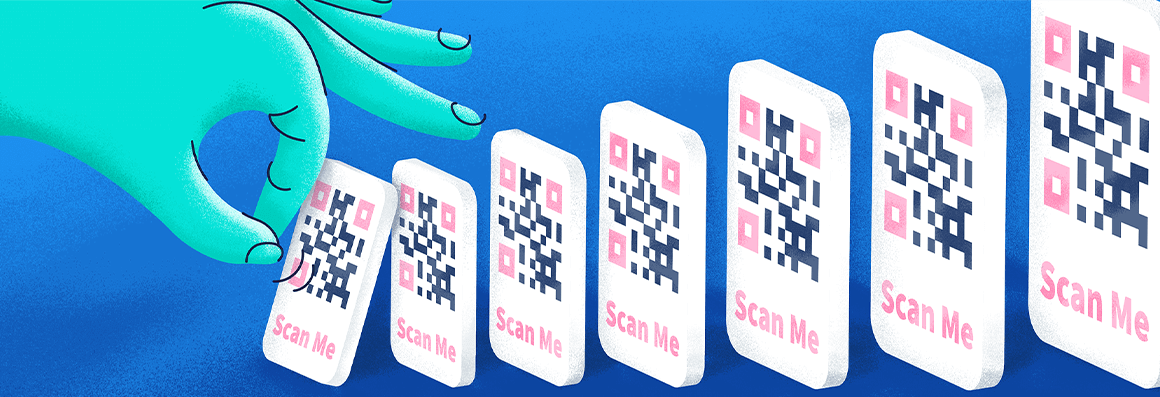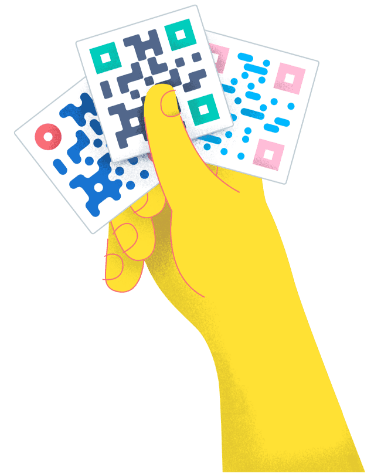- Best Practices ●
- COVID-19 ●
- Industry Trends ●
- Partners ●
- Product ●
How To Upgrade Your Digital Marketing Strategy With QR Codes
Quick Response Codes are 2D barcodes that users can scan with their mobile devices to access the embedded information. When you apply these codes to your marketing, they entice customers to take action and engage with your product, cause, or service.
Digital marketers who harness these codes can reinforce their branding and improve customer engagement with both current and prospective users.
So, let’s look at how and where digital marketers can integrate these customizable tools to improve their overall strategy.
Benefits of using QR Codes in digital marketing campaigns
Simple, fast, and versatile, QR Codes have been on the rise in recent years—and usage is expected to climb to 99.5 million users in 2025! QR Codes serve as an invite to customers in digital marketing campaigns, whether they’re on a bench, flier, or email.
One of the main benefits of QR Codes is the ability to take customers deeper into marketing materials and promos by giving them an easy way to access helpful information or exciting offers.
Digital ad QR Codes do more than spark curiosity, though—they serve as an immediate, contactless bridge between brand and customer. For instance, you might include a Dynamic QR Code on a social media post so customers can quickly scan the code to enter a contest from their mobile account.
Improved campaign tracking

In the past, marketers were limited to Static QR Codes, which offered little flexibility and no tracking capabilities. Today’s Dynamic QR Code campaign tracking is accurate and thorough, with instant metrics that you can use for short- and long-term decision-making.
Marketers can view the total number of scans, the number of unique scans, scan locations, and even device operating systems. So, if you’re promoting a new product across several platforms, you can instantly assess which codes are performing best. From there, you can analyze the user demographics to determine an accurate ROI estimate.
Easier editing with Dynamic QR Codes
The introduction of Dynamic QR Codes changed the game for marketers and vastly contributed to the rise in QR Code usage. Not only can you track them, but you can also edit them after they’re printed. So if you made a mistake in your URL or need to change it for any reason, you don’t need to redesign and redistribute your materials.
For instance, let’s say a team is working on a new web page, and marketers plan to promote the page via QR Codes across multiple print channels. They can create Dynamic QR Codes that link to a dummy site before updating the QR Code to the real site as soon as the developers are done.
You can also use Dynamic QR Codes to extend the lifespan of a limited-time campaign. Say you’re only licensing a video or image for a few months. You can design your marketing campaigns to promote it, but leave the language loose enough to switch to evergreen content once the license expires.
Dynamic QR Codes help you preserve your timeline and budget while improving the efficacy of your efforts.
More marketing uses and applications
QR Code applications both increase and improve with every passing year. You can print them on nearly any material, including billboards, table tents, product packaging, and receipts.
Marketers can use them to introduce anything from new payment options to large-scale events to customer satisfaction surveys. Whether increasing social media followers or launching a new product, you can adapt QR Codes to fit multiple digital marketing elements.
Increased brand awareness and individuality
You might think of QR Codes as generic black-and-white squares, but more and more companies are taking advantage of custom QR Codes. Marketers can add branding elements to these codes, such as logos, colors, or a specific call to action (CTA) to improve awareness.
When you use the right platform, It’s simple to add your brand’s unique personality with customizable QR Code frames and professional-grade design tools. QR Code Generator PRO offers endless possibilities for QR Code customization.
Pro tip: If you’re looking for more information on how to design QR Codes, check out our guide to the individual design of QR codes.
How to create a digital marketing strategy
Creating a digital marketing campaign can be a highly technical and complex process. No matter how experienced the marketer is, it requires some degree of experimentation. The good news is that it’s comparable to the basic process of building a results-oriented campaign.
1. Define campaign goals
The first step in designing a digital marketing campaign is defining a clear set of metrics by listing and prioritizing each goal and determining how to measure them.
For instance, you might want to increase brand awareness more than you want to generate revenue. Or you may want to improve the quality of leads rather than the number of leads. Identifying your goals and how to track them gives you a foundation to build on.
2. Analyze your target audience
The next step is understanding who your audience is. Once you know your customers’ age bracket, location, needs, and expectations, it’s easier to define how and where to market.
For example, if you’re advertising to both businesses and individuals, you’ll have to decide how to either split up the campaign or craft language to appeal to both brackets. If you’re using QR Codes in a split campaign, you can direct consumers to one landing page and professionals to another for the same product or service.
3. Analyze previous marketing efforts
Previous marketing efforts can provide insight into your current strategies. So it’s a good idea to dive deep into which efforts worked, who they reached, and how technology has changed since then. You’ll also want to assess why these strategies worked where others might have failed.
Say you previously used shortened links on physical promotional materials, such as flyers or posters. You can increase engagement with QR Codes for a more immediate connection to the brand. This eliminates barriers and makes it simple for users to engage with your products or services.
4. Configure the marketing budget and marketing channels
The combined information from campaign goals, target audiences, preferred channels, and previous campaign data is the foundation for your new digital marketing strategy.
But keep in mind that your budget needs to support your plan for at least a few months. While it can be tempting to change up a strategy that seems like a failure, digital marketing takes time to reveal its true results. For example, if you’re paying for digital ad space in an industry newsletter on a monthly basis, be sure to factor that expense into your marketing budget for at least six months or so.
This tip doesn’t mean that you can’t change individual elements of your strategy, such as broken links or specific messaging. But you should plan on sticking with the core strategy and giving it time to work.
5. Create a value-focused content strategy
Once you’ve finalized the overall strategy, it’s time to narrow down the content you’ll use—such as copy, colors, graphics, images, videos, and the like. Plus, you’ll need to decide what, where, and when to post.
For instance, if you’re debuting a new car wash service, you might post one SEO blog a week and hand out flyers in strategic locations with a QR Code that people can scan for a discount. These details set a foundation for distribution, which can have a significant effect on how people engage with new content.
6. Implement the campaign
As you put the plan into action, be sure to give yourself enough time to gather sufficient data. Plenty of strategies take a while to start generating results, and it’s not always possible to judge the outcome based on an initial lukewarm response.
A major part of marketing is giving customers a convenient way to engage. QR Codes can help your customers take action immediately, making them particularly valuable in a world of distractions.
7. Monitor the campaign
You’ll want to keep detailed data records so you can compare the success rates of different content and platforms. Pay close attention to whether your target market is truly engaging with your content or not.
For instance, if there are endless QR Code scans for your landing page, but people are clicking off it immediately, it’s a sign that the landing page may need adjustments.
8. Adjust for improvements
The last step is to use the metrics to adapt your strategy, as sometimes even the smallest changes can have the biggest results. It could be as simple as using the same content but switching it from Facebook to Instagram.
One way to determine whether a campaign is working is to track the immediate results from QR Codes. With the right methodology, you can see how people are responding in real time:
- Scans over time (customizable)
- Scans by operating system
- Scan location (country & city)
- Unique scans
From there, tools like Google Analytics can take you a step further to determine the true impact of your content and marketing strategy.
How to integrate QR Codes with your digital marketing strategy
While you can integrate QR Codes nearly anywhere across your digital marketing strategy, it’s important to have a targeted plan of attack. Let’s look at some ways to maximize your marketing campaigns with QR Codes.
Reevaluate the objectives for potential use cases
In addition to setting goals for your marketing strategy, you need to set specific goals for QR Codes. This includes evaluating the end result against the needs of your audience.
So, if you’re promoting a text-heavy website with a QR Code, consider whether your audience has time to peruse a website at the time of scan. Placing a QR Code in a location where people are often in a rush may lead to high scan rates and equally high bounce rates.
Include QR Codes in social media marketing strategies
You can integrate Social Media QR Codes into social media campaigns to promote multiple channels. With QR Code Generator PRO, you can create one QR Code to link to different platforms, giving people options if they favor one social media platform over another.
Considering most companies usually have a preferred channel (such as TikTok for brands that cater to teenagers), QR Codes are versatile enough for all demographics to use. For example, you might feature a QR Code on a landing page to instantly connect visitors to your LinkedIn company page.
Enhance email marketing campaigns
QR Codes can streamline nearly any form of communication, including email. For instance, marketers might print a Feedback QR Code on a poster that immediately links to a company email address and pre-filled survey form. This reduces the time and effort for customers to share their feedback.
Or you can use codes within emails to promote exclusive offers to different audience segments. When you make the deals available via email, you can improve open rates and generate more excitement for your brand.
Link offline marketing materials to landing pages
Because you can print QR Codes on nearly any material, they seamlessly link your digital and offline marketing efforts. Whether in a brick-and-mortar window display or on a business card, integrating QR Codes can improve customer interactions by directing them to useful content.
For instance, if you were marketing a new product, you might print a QR Code directly on the packaging that links to a demo video demonstrating how to use the product in different ways. This not only helps your customer understand what they’re purchasing beforehand, but it improves their overall impression of your brand.
Personalize the customer experience
In today’s one-on-one culture, customer segmentation is the key to success. Once you’ve separated your audience into different categories, you can use QR Codes to personalize the user experience.
For instance, you might mail a postcard with a QR Code to repeat customers offering a discount on a favored product. Or you could send eco-conscious customers an email with QR Codes that link to more information about the company’s conservation efforts.
Going the extra mile helps customers feel seen and can help marketers gather more honest feedback for better decision-making.
Place QR Codes strategically
Thanks to the combination of QR Code Generator PRO’s tracking capabilities and Dynamic URL Codes, testing landing pages for different locations is easier than ever. Metrics like operating system, time, and location can tell marketers plenty about how people access information and what they do with it.
This is especially valuable for international companies with diverse audiences. QR Codes can link to content in different languages, so there are no barriers to promos or deals.
As you experiment with both the geographical location and the QR Code positioning on your marketing materials, you can see which codes work best in which places.
Boost app downloads
Mobile app use has grown exponentially. In fact, users spend 88% of their mobile time on apps. Apps are invaluable tools for companies to offer real value to customers—and a key element in your digital marketing strategy.
QR Codes can quickly link customers to your digital asset on an app store, cutting down the effort needed to download and set up the app. If you’re going to invest the time and money to make the app, you’ll also need to put equal effort into encouraging customers to sign up for it—which is why QR Codes for app marketing can be so valuable.
Start improving conversion rates with QR Code marketing techniques today
With QR Codes, marketers can meet current and potential customers where they are, not the other way around. They’re a cost-effective way to connect a company’s target markets to useful materials that reinforce the brand’s core values.
Whether you’re pushing budget-friendly products, luxury services, or charitable causes, all digital marketers can benefit from incorporating QR Codes into their campaigns.
If you’re ready to create a better digital marketing strategy, get started with QR Code Generator PRO today!





